Page 118 of 416
116
Air distribution
Windscreen and side windows.
Central and side air vents.
Footwells.
The air distribution can be adapted by actioning
the corresponding buttons.
Air conditioning
With the engine running, the air conditioning is
designed to operate effectively in all seasons,
with the windows closed.
It allows you:
-
i
n summer, to lower the temperature,
-
t
o increase the effectiveness of the
demisting in winter, above 3°C.
Switching on
F Press this button, its indicator lamp comes on.
The air conditioning does not operate
when the air flow adjustment is set to off. To cool the air more quickly, you can
use recirculation of the interior air for
a few moments. Then return to the
intake of exterior air.
Switching off
F Press this button again, its indicator lamp goes off.
Switching the system off could result in
discomfort (humidity, condensation).
Ease of use and comfort
Page 119 of 416
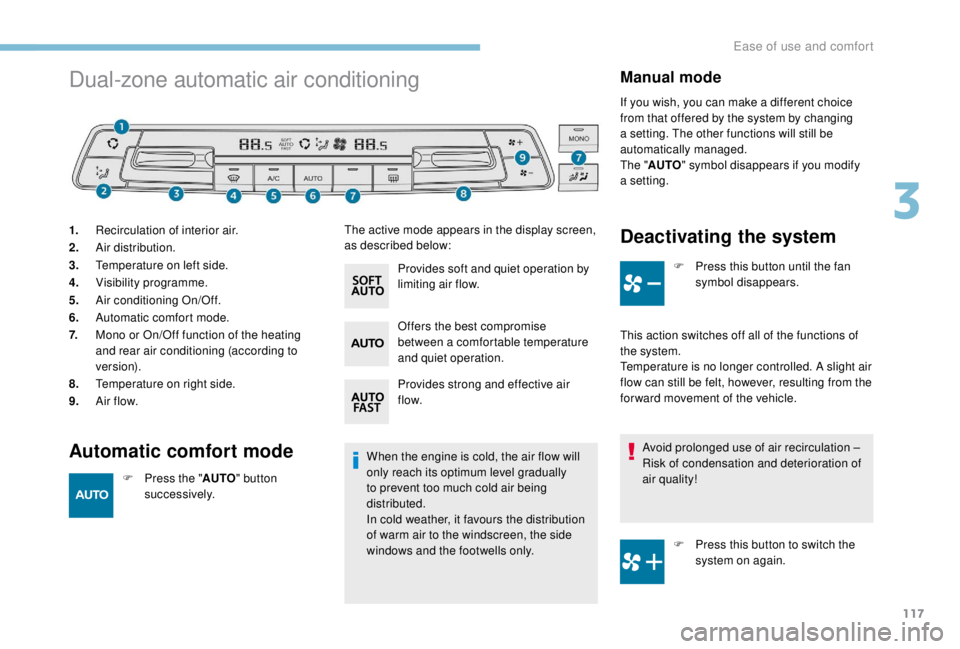
117
Dual-zone automatic air conditioning
Automatic comfort mode
1.Recirculation of interior air.
2. Air distribution.
3. Temperature on left side.
4. Visibility programme.
5. Air conditioning On/Off.
6. Automatic comfort mode.
7. Mono or On/Off function of the heating
and rear air conditioning (according to
ve r s i o n).
8. Temperature on right side.
9. A ir f low.
When the engine is cold, the air flow will
only reach its optimum level gradually
to prevent too much cold air being
distributed.
In cold weather, it favours the distribution
of warm air to the windscreen, the side
windows and the footwells only.
Manual mode
If you wish, you can make a different choice
from that offered by the system by changing
a setting. The other functions will still be
automatically managed.
The "AUTO " symbol disappears if you modify
a setting.
F
P
ress the " AUTO" button
su c c e s s i ve l y. Provides soft and quiet operation by
limiting air flow.
Offers the best compromise
between a comfortable temperature
and quiet operation.
Provides strong and effective air
f low.
Deactivating the system
F Press this button until the fan
symbol disappears.
This action switches off all of the functions of
the system.
Temperature is no longer controlled. A slight air
flow can still be felt, however, resulting from the
for ward movement of the vehicle. Avoid prolonged use of air recirculation –
Risk of condensation and deterioration of
air quality!
F
P
ress this button to switch the
system on again.
The active mode appears in the display screen,
as described below:
3
Ease of use and comfort
Page 121 of 416
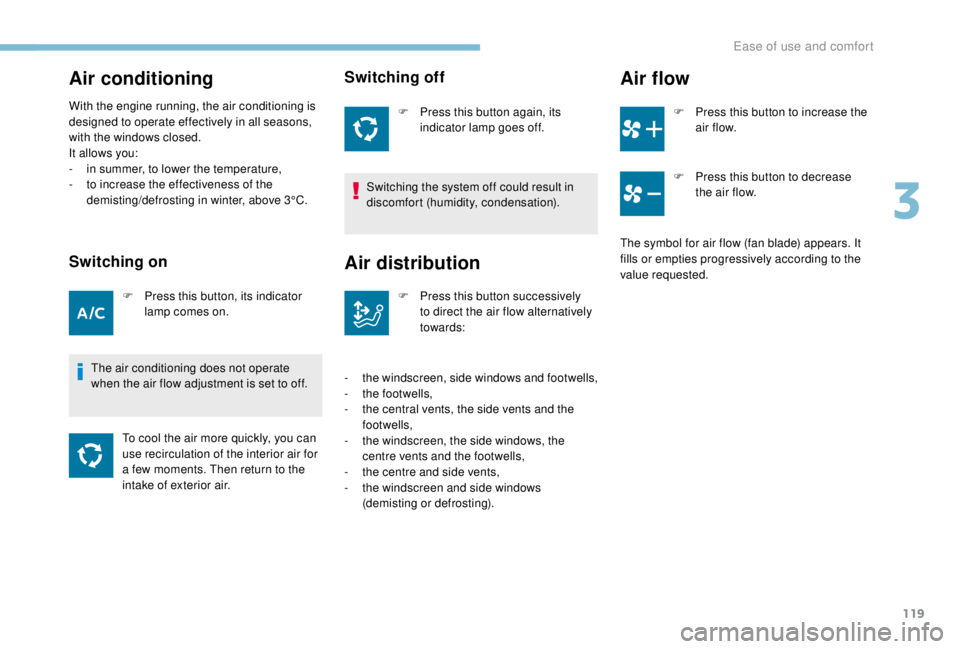
119
Air conditioning
With the engine running, the air conditioning is
designed to operate effectively in all seasons,
with the windows closed.
It allows you:
-
i
n summer, to lower the temperature,
-
t
o increase the effectiveness of the
demisting/defrosting in winter, above 3°C.
Switching on
F Press this button, its indicator lamp comes on.
The air conditioning does not operate
when the air flow adjustment is set to off. To cool the air more quickly, you can
use recirculation of the interior air for
a few moments. Then return to the
intake of exterior air.
Switching off
F Press this button again, its indicator lamp goes off.
Switching the system off could result in
discomfort (humidity, condensation).
Air distribution
F Press this button successively to direct the air flow alternatively
towards:
-
t
he windscreen, side windows and footwells,
-
t
he footwells,
-
t
he central vents, the side vents and the
footwells,
-
t
he windscreen, the side windows, the
centre vents and the footwells,
-
t
he centre and side vents,
-
t
he windscreen and side windows
(demisting or defrosting).
Air flow
F Press this button to increase the air f low.
F
P
ress this button to decrease
the air flow.
The symbol for air flow (fan blade) appears. It
fills or empties progressively according to the
value requested.
3
Ease of use and comfort
Page 123 of 416
121
Heated windscreen and washer jets
For more information on the Wiper
control stalk and in particular the heated
windscreen and washer jets, refer to the
corresponding section.
With Stop & Start, when demisting/
defrosting has been activated, STOP
mode is not available.
Door mirrors demist –
defrost
Switching on
F Press this button to demist / defrost the door mirrors; its
indicator lamp comes on.
Switching off
Demisting/defrosting switches off automatically
to prevent excessive electrical consumption. F
I
t is possible to stop the
demisting/defrosting operation
before it is switched off
automatically by pressing this
button again; its indicator lamp
goes off.
Switch off the demisting/defrosting of
the rear screen and door mirrors as
soon as appropriate, as lower current
consumption results in reduced fuel
consumption.
Door mirror demisting and defrosting only
operates with the engine running.
3
Ease of use and comfort
Page 124 of 416
122
Rear screen demist –
defrost
Switching on
F Press this button to demist /defrost the rear screen and the
door mirrors (if your vehicle is
so equipped); its indicator lamp
comes on.
Switching off
Demisting/defrosting switches off automatically
to prevent excessive electrical consumption.
F
I
t is possible to stop the
demisting/defrosting operation
before it is switched off
automatically by pressing this
button again; its indicator lamp
goes off.
Switch off the demisting/defrosting of
the rear screen and door mirrors as
soon as appropriate, as lower current
consumption results in reduced fuel
consumption.
Rear screen demisting/defrosting can only
be operated when the engine is running.
Ease of use and comfort
Page 125 of 416
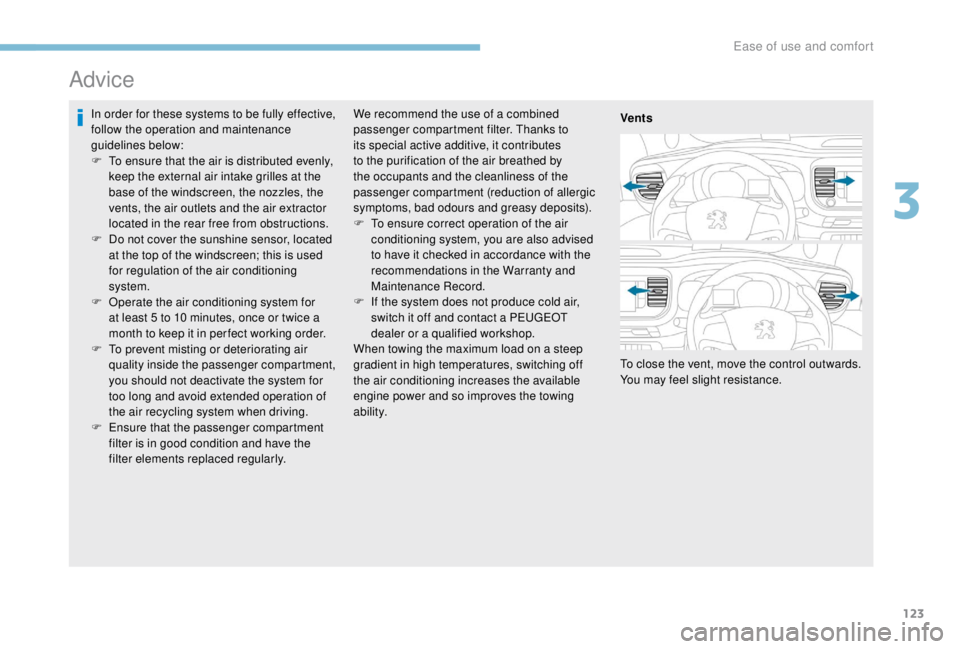
123
Advice
In order for these systems to be fully effective,
follow the operation and maintenance
guidelines below:
F
T
o ensure that the air is distributed evenly,
keep the external air intake grilles at the
base of the windscreen, the nozzles, the
vents, the air outlets and the air extractor
located in the rear free from obstructions.
F
D
o not cover the sunshine sensor, located
at the top of the windscreen; this is used
for regulation of the air conditioning
system.
F
O
perate the air conditioning system for
at least 5
to 10 minutes, once or twice a
month to keep it in per fect working order.
F
T
o prevent misting or deteriorating air
quality inside the passenger compartment,
you should not deactivate the system for
too long and avoid extended operation of
the air recycling system when driving.
F
E
nsure that the passenger compartment
filter is in good condition and have the
filter elements replaced regularly. We recommend the use of a combined
passenger compartment filter. Thanks to
its special active additive, it contributes
to the purification of the air breathed by
the occupants and the cleanliness of the
passenger compartment (reduction of allergic
symptoms, bad odours and greasy deposits).
F
T
o ensure correct operation of the air
conditioning system, you are also advised
to have it checked in accordance with the
recommendations in the Warranty and
Maintenance Record.
F
I
f the system does not produce cold air,
switch it off and contact a PEUGEOT
dealer or a qualified workshop.
When towing the maximum load on a steep
gradient in high temperatures, switching off
the air conditioning increases the available
engine power and so improves the towing
ability. Vents
To close the vent, move the control outwards.
You may feel slight resistance.
3
Ease of use and comfort
Page 126 of 416
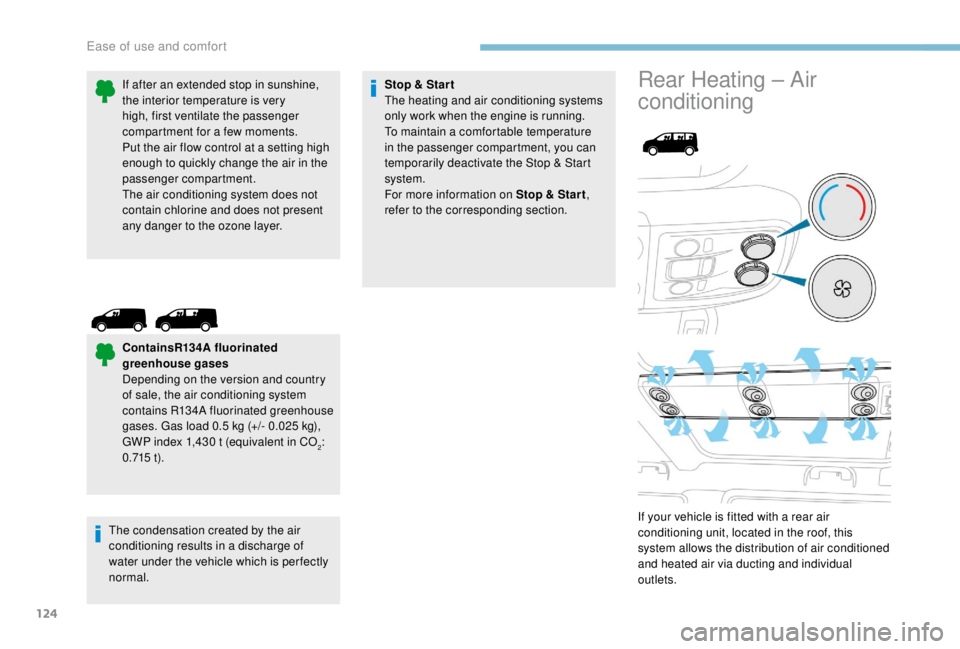
124
If after an extended stop in sunshine,
the interior temperature is very
high, first ventilate the passenger
compartment for a few moments.
Put the air flow control at a setting high
enough to quickly change the air in the
passenger compartment.
The air conditioning system does not
contain chlorine and does not present
any danger to the ozone layer.
ContainsR134A fluorinated
greenhouse gases
Depending on the version and country
of sale, the air conditioning system
contains R134A fluorinated greenhouse
gases. Gas load 0.5 kg (+/- 0.025 kg),
GWP index 1,430
t (equivalent in CO
2:
0.715
t).
The condensation created by the air
conditioning results in a discharge of
water under the vehicle which is per fectly
normal. Stop & Star t
The heating and air conditioning systems
only work when the engine is running.
To maintain a comfortable temperature
in the passenger compartment, you can
temporarily deactivate the Stop & Start
system.
For more information on Stop & Star t
,
refer to the corresponding section.
Rear Heating – Air
conditioning
If your vehicle is fitted with a rear air
conditioning unit, located in the roof, this
system allows the distribution of air conditioned
and heated air via ducting and individual
outlets.
Ease of use and comfort
Page 127 of 416
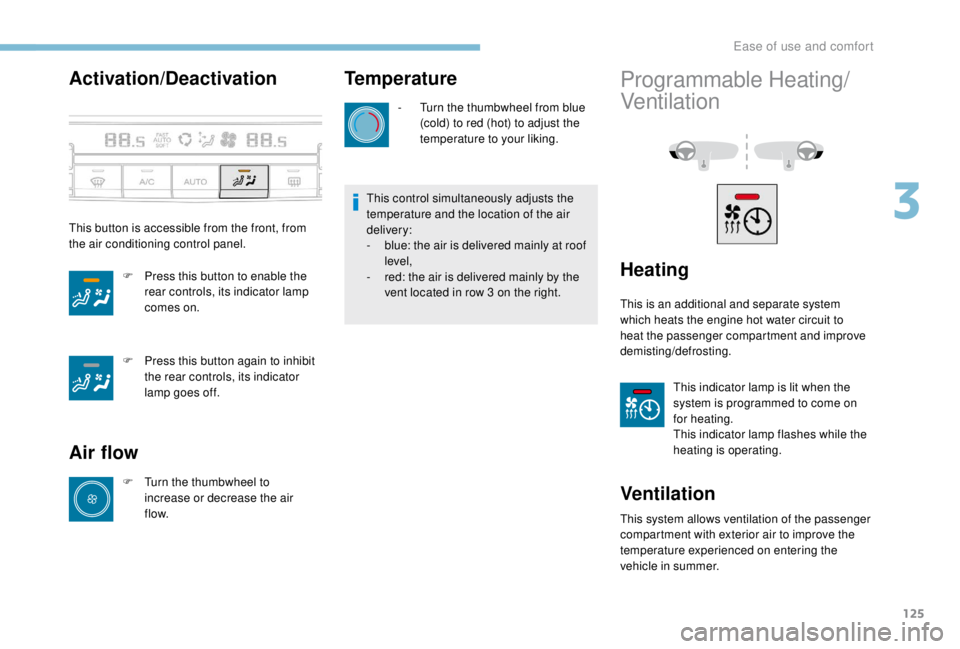
125
Activation/Deactivation
This button is accessible from the front, from
the air conditioning control panel.F
P
ress this button to enable the
rear controls, its indicator lamp
comes on.
F
P
ress this button again to inhibit
the rear controls, its indicator
lamp goes off.
Air flow
F Turn the thumbwheel to increase or decrease the air
f low.
Programmable Heating/
Ventilation
Heating
This is an additional and separate system
which heats the engine hot water circuit to
heat the passenger compartment and improve
demisting/defrosting.
This indicator lamp is lit when the
system is programmed to come on
for heating.
This indicator lamp flashes while the
heating is operating.
Ventilation
This system allows ventilation of the passenger
compartment with exterior air to improve the
temperature experienced on entering the
vehicle in summer.
Temperature
- Turn the thumbwheel from blue (cold) to red (hot) to adjust the
temperature to your liking.
This control simultaneously adjusts the
temperature and the location of the air
delivery:
-
b
lue: the air is delivered mainly at roof
level,
-
r
ed: the air is delivered mainly by the
vent located in row 3
on the right.
3
Ease of use and comfort